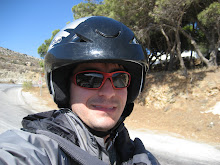I was walking to work today hoping that it would warm up a bit more when I saw something peaking through the haze I had not seen since I was in Chicago, the sun. Part of the reason I had not seen the sun has been the cloud cover. It was raining in Hong Kong, and snowing when I got to Xian. The other part is the pollution though out China.
As you walk around the cities here you might say, “Wow, it sure is foggy here. The buildings begin to get fuzzy just half a block away, and they are completely enveloped by the fog about a kilometer away.” Well, this is not fog. It is pollution. Along with not seeing the sun in China you will rarely see planes, helicopters, clouds, stars, or blue skies.
You are probably thinking to you self, That is crazy Rick you are exaggerating. No city could be that polluted all year round with only a few “blue sky days.” Where can all of this pollution come from? In fact not only this city can be this way but many cities are this way. Planning for the Beijing Olympics, which will be occurring this summer, has included removing much of the industry from the city and moving it elsewhere in the country, some to my beautiful city of Xi’an (which was already one of the industrial capitals). Power plants in the area will be shutting down in the weeks ahead of the games to help clean the air. Millions of trees have been planted around the city of Beijing. The government was thrilled that this last year had 246 “blue sky days” beating their goal for the year by a day. China “blue sky days” are a bit different than US some of theirs would actually be “ozone action days” in Chicago where the sun’s ultra violet light activates some of the pollutants in the air and forms the haze that we see often only on the hottest of summer days.
The pollution has many sources. Similar to the North America the wind blows from west to east on most day. It picks up pollutants from Europe and now the fast developing Eastern European block countries and carries it across the continents while picking up more pollutants. A study released a couple years ago (I saw the article on the BBC News or MSNBC and don’t feel like finding the link now) found that much of the worst air pollution in the world actually comes from rural China. The farmers burn their garbage and their fields after the harvest. This releases amazing amounts of chemicals into the air. Additionally rice farming in general produces large quantities of methane gas. All of these pollutants are picked up by the winds as they proceed east. They combine with the pollution given off by the factories that supply the world with goods, and the vehicles that move those goods and the laborers that produce them. The Chinese economy has been growing at better than 10% per year for the last 15 years, that means that they double their economies size in less than 7 years(many times in less than 5 years).
If you are a science teacher you can do an environmental impact experiment (also an example of diffusion) using a large beaker of water, milk, and eye dropper. Take the milk in the eye dropper SLOWLY putting one drop of milk in the beaker, and say that “each drop of milk is one year’s pollution.” (If it is a smaller beaker say it is 10 years) Do 100 years or just 20 years and you will see the difference. Also you will see how the pollution lingers in the spot that you drop the milk. Variations include wind (simulated by stirring before you put the milk in) and emerging markets by adding drops in different areas of the beaker. I don’t know if you can do it at different altitudes (depths) but that might be fun too. Oh, and try putting it over a heat source and see if convection currents distribute it differently.
Just so everyone knows I am sorry if the format of this blog is not very good I am allowed to post my entries, but I am not allowed to view them. China blocks blogs and my BBC news L so I can not see what it looks like.

No comments:
Post a Comment